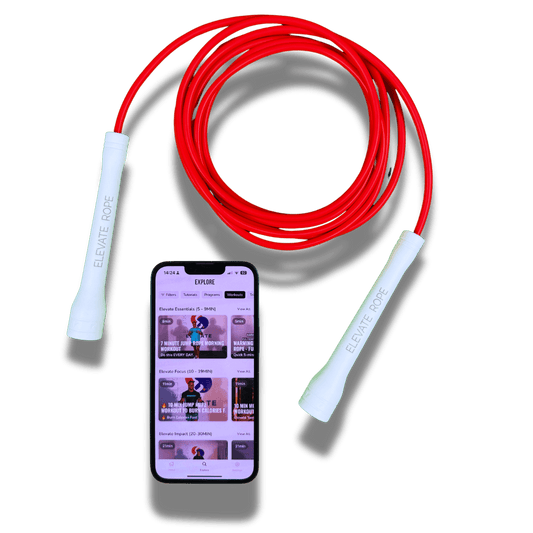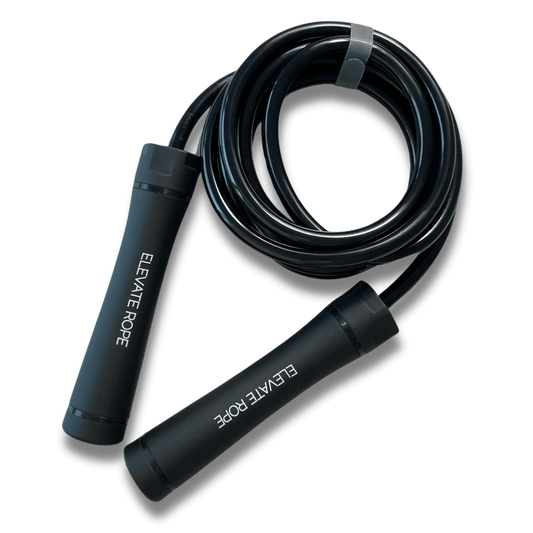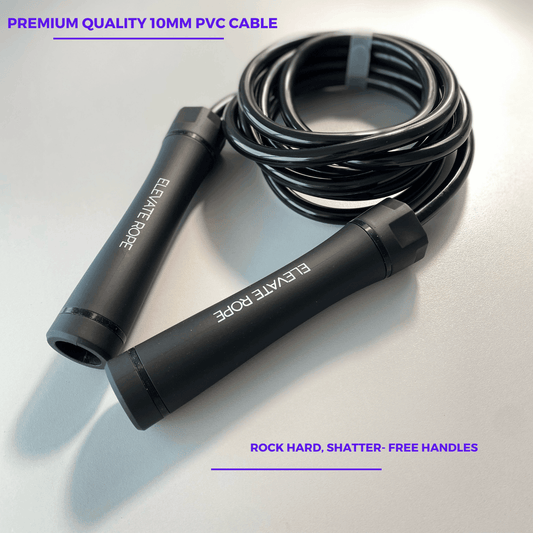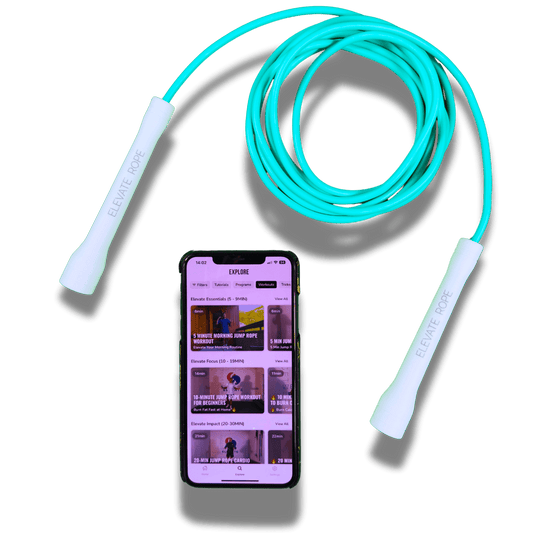You don’t need a gym full of machines to build real strength — just rhythm, resistance, and a heavy rope.
Weighted jump ropes are one of the most underrated tools in fitness. They don’t just improve coordination or burn calories; they train your body to generate controlled power through constant resistance. Every swing is a small battle between momentum and muscle — and the heavier your rope, the greater the reward.
Whether you’re training in your living room, outdoors, or between meetings, 15 minutes with a heavy rope can build more strength, endurance, and focus than most hour-long workouts. The best part? You only need one tool — and total commitment.
Grab your weighted rope — or check out the Ascent MAX Bundle — and get ready to unlock a new level of full-body power.

The Science Behind Weighted Rope Training
When you pick up a weighted rope, you’re not just doing cardio. You’re activating nearly every muscle group in your body through rotational resistance. The constant tension of the rope forces your shoulders, forearms, and core to stabilize every movement, while your legs drive rhythm and balance.
A 2024 study on rope resistance training found that muscle activation in the shoulders and upper back increased by over 30 percent compared to traditional jump rope workouts. The extra load challenges the fast-twitch muscle fibers that improve explosiveness, and it elevates heart rate faster, resulting in higher calorie burn per minute.
Physiologically, this makes heavy-rope training a hybrid between cardio and strength work — you’re improving cardiovascular health while stimulating muscle growth and neuromuscular coordination. In short: you build endurance and power at once.
Unlike dumbbells or machines, a rope moves dynamically, demanding control and rhythm. Every swing becomes a test of timing — a conversation between your brain and body.
👉 Learn more: How Weighted Ropes Improve Shoulder and Core Stability
The 15-Minute Heavy Rope Routine for Total-Body Power
This routine is short, efficient, and guaranteed to test your limits. You’ll rotate through explosive movements that activate your legs, arms, and core while maintaining constant rhythm.
All you need: a weighted rope (0.75 – 1 kg for intermediate athletes) and 15 minutes of focus.
| Section | Exercise | Duration | Focus |
| Warm-Up | Light single unders | 2 min | Coordination, rhythm |
| Block 1 | Heavy rope basic jumps | 1 min × 3 | Legs, calves, cardio |
| Block 2 | Side swings + alternate foot steps | 1 min × 3 | Core, arms |
| Block 3 | Jump-rope squats | 1 min × 3 | Glutes, quads |
| Block 4 | Boxer step with heavy rope | 1 min × 3 | Endurance, flow |
| Cool-down | Slow rope flow + stretch | 2 min | Recovery |
Tip: Rest 30 seconds between rounds. Focus on smooth control, not speed.
Each movement recruits stabilizer muscles that most cardio workouts ignore. As the rope cuts through the air, your body instinctively braces — teaching functional tension that translates into better performance in every sport.
Finish with slow, controlled side swings and shoulder rolls to flush lactic acid.
What Makes Weighted Rope Training So Effective
Traditional strength workouts isolate — you push, pull, or lift in one direction. Jumping with a heavy rope integrates everything. It demands full-chain coordination from your hands through your core to your feet.
Here’s why it outperforms most cardio:
- Time efficiency: 15 minutes of heavy-rope work can match the calorie burn of 30 minutes of running.
- Muscle endurance: Every rep is resistance training for your shoulders, traps, and grip.
- Metabolic boost: The combination of cardio and resistance triggers an “afterburn” — your body keeps burning calories for hours.
- Portability: One tool fits in any backpack. Train anywhere.
| Workout Type | Muscle Groups Engaged | Calories Burned (15 min) | Equipment Needed |
| Running | Lower body | ≈ 180 kcal | Shoes |
| Cycling | Lower body | ≈ 160 kcal | Bike |
| Weighted Jump Rope | Full body | 220 – 250 kcal | Rope only |
It’s resistance training disguised as rhythm — high output, low complexity.
👉 Compare more: Jump Rope vs Running — Which Burns More Fat?

Choosing the Right Rope Weight
Picking the right rope weight determines your performance and safety. Too light, and you won’t build strength. Too heavy, and you’ll sacrifice form and flow.
| Level | Recommended Weight | Focus |
| Beginner | 0.25 – 0.5 kg | Learn rhythm and coordination |
| Intermediate | 0.75 – 1 kg | Develop endurance and tone |
| Advanced | 1.25 – 2 kg + | Build explosive power and stability |
For most athletes, a 1 kg weighted PVC rope hits the sweet spot — heavy enough to challenge, light enough to stay fluid.
Material matters too. PVC ropes create consistent feedback in each swing, while beaded ropes offer more control and visual rhythm, great for flow training.
If you’re serious about results, the Ascent MAX Weighted Rope is built for optimal resistance, ergonomic grip, and durability — engineered to turn every 15-minute session into a total-body challenge.
The 15-Minute Philosophy: Why Less Time Can Mean More Progress
A lot of people think “short” equals “easy.” Weighted rope training proves otherwise.
Fifteen minutes of high-density movement doesn’t just work your muscles — it resets how your body handles fatigue. You’re improving your anaerobic threshold, coordination, and focus all at once.
Each jump requires control under fatigue. Each rotation tests your rhythm under pressure. This is discipline in motion.
The goal isn’t perfection — it’s presence.
The rope becomes your metronome, and your breath keeps time. When you start to fatigue, that’s where the real work begins — that’s where growth happens.
So the next time you say “I don’t have time,” remember: 15 minutes is all it takes to elevate your entire physiology.
Integrating Heavy Rope Work into Your Weekly Training
If you’re already lifting weights or doing HIIT, heavy-rope workouts can complement your schedule beautifully:
Option 1 — Strength Finisher:
End your lifting sessions with 3 × 1-minute heavy-rope sprints to spike your heart rate and improve conditioning.
Option 2 — Active Recovery:
Use a lighter weighted rope (0.5 kg) for low-intensity flows to promote blood flow and shoulder mobility.
Option 3 — Standalone Workout:
On busy days, complete the 15-minute routine above for a complete session that hits strength and cardio simultaneously.
For advanced athletes, pair the rope with bodyweight circuits — jump-rope intervals between push-ups, lunges, and planks. You’ll build muscle endurance while keeping your heart rate high.
Real-World Results: How Heavy Ropes Build Functional Strength
Weighted ropes don’t just look impressive — they create functional strength you can feel.
Athletes who integrate heavy-rope sessions 3–4 times per week often report:
- Improved shoulder endurance for sports like basketball and boxing
- Better posture and upper-back stability
- Faster recovery and more defined muscle tone
- Mental resilience from short, high-intensity challenges
One Elevate athlete described it best:
“With the Ascent MAX, I feel every muscle working. It’s not just cardio — it’s control, timing, and pure power.”
When you combine resistance and rhythm, you train your nervous system to move efficiently. This transfers to everything — from lifting to sprinting to daily movement.

Recovery & Rope Care
As with any resistance training, recovery is part of progress.
After each session:
- Cool down: 2 minutes of slow rope flow, then stretch your shoulders, triceps, and calves.
- Hydrate: Weighted sessions deplete energy faster — drink water or an electrolyte mix.
- Clean & Store: Wipe your rope, avoid concrete, and store it flat or hung to prevent kinks.
Treat your rope like your workout partner — the better you care for it, the longer it performs.
👉 Learn more: Top 5 Rope Maintenance Tips
The Mental Edge: Strength Beyond the Physical
Heavy-rope training isn’t just about building muscle — it builds mindset.
When your shoulders burn and your breath shortens, you face the same mental wall athletes know too well. Each swing teaches patience under pressure. Each set builds confidence through consistency.
That’s why rope athletes often describe their sessions as meditative. The rhythm becomes grounding; it silences distractions and forces focus. You emerge from 15 minutes not just stronger, but sharper — calm, yet energized.
Jumping rope reconnects you with your body. It reminds you that movement can be both power and peace.
Ready to Build Power with Purpose?
Stop chasing time — master it.
Fifteen minutes a day can rebuild your strength, stamina, and confidence from the ground up.
This isn’t about training harder — it’s about training smarter.
Grab your rope, put on your playlist, and feel every swing bring you closer to the strongest version of yourself.
Train smarter. Move stronger. Elevate your rhythm.
Ready?














